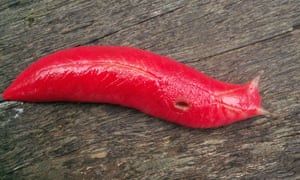Fluorescent pink slug, unique to Australian mountaintop, survives bushfires
Around 60 of the brightly coloured Mount Kaputar slugs have been spotted, but fires have burnt their habitat
A fluorescent pink slug, found only on a single mountaintop in northern New South Wales, has survived the bushfires that burnt through much of its alpine habitat.
Around 60 of the brightly coloured Mount Kaputar slugs, which can grow to a size longer than a human hand, were spotted by National Parks and Wildlife Service rangers after recent rainfall in Mount Kaputar national park.
The Kaputar fire burnt through the area for more than six weeks from October to December 2018, affecting more than 18,000 hectares of land.
The mountain was formed by a now-extinct volcano, and is home to at least 20 species of snails and slugs found nowhere else in the world. The area has been identified as an endangered ecological community, the first of its kind in Australia.
Some of the fluorescent slugs would have managed to survive the fire because they had “retreated into rock crevices” in the heat, the Australian Museum malacologist Frank Köhler said.
Meet Triboniophorus aff. graeffei, a giant fluorescent pink slug that only lives on an extinct volcano in New South Wales, Australia
(Photo: Michael Murphy)
980 people are talking about this
But around 90% of the slug population, which also hibernates in bark and trees, would have been killed in the fire, he said.
Much of the slug’s food sources – fungi, moss and mould – would also have been burnt by the fire, but Köhler said these species should recover relatively quickly.
In coming months the slug might be at risk of being seen more easily in the burnt landscape by hungry birds and mammals, said Köhler, but the bright colour could also act as a warning to dissuade the predators.
The unmistakable slug is a “poster boy for snails and slugs” because of its distinctive colour, Köhler said, “but it comes with a number of other species that are similarly threatened by the fires that don’t get the same attention”.
The Mount Kaputar ecological community includes three species of carnivorous snails found nowhere else in the world.
Is it a leaf? ...No... Is it bark?...No... It's Pinky!!! Mt Kaputar pink slug @AustmusResearch @austmus
25 people are talking about this
While the Mount Kaputar slug may take around five years to recover from the fires, the snails could take 20 years, Köhler said, because “their lifespan is longer and they produce fewer offspring”.
Their food source, primarily earthworms and other snails, is also likely to have been heavily affected by the fires.
Slugs and snails “are the foundation of all of our ecosystems”, Köhler said. “They are the foundation food source for many mammals and birds.”
But while invertebrates represent 99% of all species in Australia, “they don’t get even close to representative funding in research and conservation,” he said.
“Species don’t exist independent of other species, and we need to try to maintain the whole system and all the species within in it against environmental impacts such as the fires,” Köhler said.
Bushfires are not the only threat facing the unique species.
“They are not likely to be able to adapt to a very fast-changing climate,” he said. “It’s more likely than not that they will go extinct,” Köhler said.
“A warming of only 2C would be enough to wipe out the entire [ecological] community” he said.
Because the species are found at the summit of the mountain, “they will not be able to move higher to escape increased temperatures”.
Mount Kaputar national park is still affected by the bushfires and is closed to visitors until 28 February.






Comments
Post a Comment